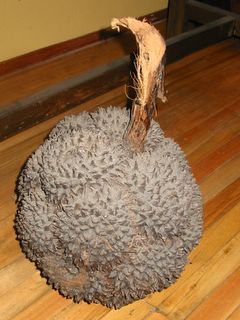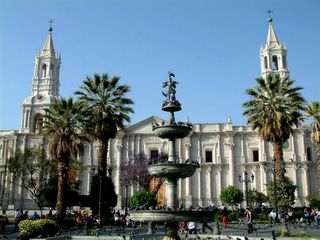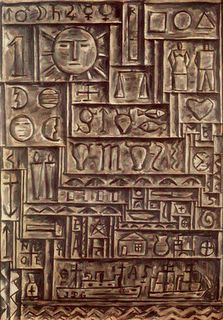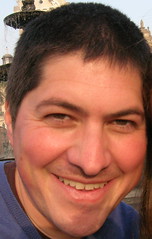2.24.2005
Buenos días
2.22.2005
Places I'd like to live...

Yours for the price of a McMansion in the states: 5,800 square feet on the top 3 floors of a classic French apartment building in Buenos Aires, Argentina. Elegance inside and out, but with the air of impoverished nobility. Give in to your inner Porteño. Make an offer now!
Alien's eye view of Machu Picchu

Click the photo to view in extreme detail. Can you spot any yet-undiscovered ruins? Give yourself extra points if you can name the town in the upper left.
2.20.2005
All aboard for the world's highest train ride
The Ferrovias Central Andino leaves Lima, Peru (at sea level)...

...and climbs directly into the foothills of the Andes...

...up through beautiful highland valleys...

...past hard-scrabble villages...

...desolate mining operations...

...a British-built train station at 13,642 feet...

...through a tunnel at 15,610 feet, which marks the high point of the trip...

...across the highland plain...

...until the train arrives at Huancayo.

See the complete photo journal of this ride and other amazing train journeys at the Kells Transport Museum Website.

...and climbs directly into the foothills of the Andes...

...up through beautiful highland valleys...

...past hard-scrabble villages...

...desolate mining operations...

...a British-built train station at 13,642 feet...

...through a tunnel at 15,610 feet, which marks the high point of the trip...

...across the highland plain...

...until the train arrives at Huancayo.

See the complete photo journal of this ride and other amazing train journeys at the Kells Transport Museum Website.
Joaquín Torres García, Uruguayan master
Who killed Gaitan?

Jorge Eliecer Gaitan was shot in the back by an assassin as he stepped out of his office building on April 9, 1948. Gaitan was the populist candidate who was most likely to become president of Colombia. His death sparked "El Bogotazo" -- massive riots in Bogota and then in other cities. For two days Gaitan's followers held power in Bogota, until the Colombian army was unleashed on its own people, killing as many as 5,000 civilians. The years of violence that followed claimed the lives of more than 200,000 Colombians and gave birth to the country's current and ongoing political crisis.
Whodunnit? Conspiracy theories abound. One popular theory says that the CIA did it. The records show the agency was expecting armed demonstrations by Colombian leftists coinciding with a visit by U.S. General George Marshall for the signing of the charter of the Organization of American States. What's more, the U.S. believed that Gaitan was receiving funding from the Soviets. (We may never know the full story, as a number of CIA documents about the Gaitan case were destroyed in 1972.)
Some people believe that a Cuban student who was in Bogota at the time was somehow involved. He is pictured above, left. His name was Fidel Castro.
Author Gabriel Garcia Marquez a vivid and personal account of this tumultuous time in his memoir, Living to Tell the Tale.
2.18.2005
Feel the burn

In many parts of South America, chile plants aren't dainty little annuals, but bushes and trees. That's mind-blowing for a gardener in the northern climes, who has to start plants from seeds or seedlings every damn spring.
Here's a shortcut. Cross Country Nurseriesin New Jersey sells live chile plant seedlings. In fact, they claim to have the world's largest selection, with over 500 varieties. I've used them three or four times and have been quite satisfied. The plants arrive at the appropriate time for my zone and they're healthy, not withered as you might expect. However, I have noticed that they tend to run out of certain varieties, especially the rarer breeds coveted by true chileheads. So if you want to be sure of getting your wrinkly, yellow Fatali or lush, smoky Habanero-Chocolate peppers, you should place your order soon.
Bad news for elephant poachers

Tagua is made from dried and polished seeds of a palm [Phytelephas Macrocarpa] that grows around the world in rainforests located mostly near the equatorial zone. It is also known as "vegetable ivory" because of its likeness to animal ivory. See some tagua products at the Tagua Rainforest Ivory site.
La Ciudad Blanca

The Cathedral of Arequipa, located in southern Peru. Arequipa is known as the White City, because many of its ornate colonial buildings were made of a white volcanic stone that is unique to this region.
Quel rico y suave

Confession: I like good cheap wine, er, good wine that happens to be cheap. Los Vascos, from the Colchagua Valley in Chile, is high on my list. It's an affordable, widely available Cabernet that tends to sell around the $10 mark and does justice to grilled meats. (Quick aside: ever notice that wine descriptions always refer to how well the wine goes with meat dishes? Do wine afficionados eat that darned much red meat?) I haven't tried it, but I could easily imagine this wine working with a spicy lentil stew served over rice. Anyway, the bodega (winery) of Vina de Los Vascos is actually owned by the Lafite branch of the Rothschild clan. Yes, those Rothschilds -- the ones who pretty much invented banking and went on to finance centuries of war, etc. etc. Well, maybe they've turned a new leaf. I say let's give them one more chance.
A wired continent
You know, this Internet thing just might be catching on. Zooknic has published some interesting and recent (2004) statistics on world Internet usage. It's not surprising to see Chile at the top of the heap, with over 25% of its populace online. Peru, Guyana and Uruguay are the runners up (13%-25%). I can see Uruguay, but Peru? Another thing: I wonder if these stats account for all the people who rent their Internet access by the hour at their local cabina?
2.17.2005
Yours to burn and plunder

For sale: 1.2 million acres in the Brazilian Amazon. Cost: US$25 million. "Perhaps the most pristine, biologically diverse and productive tract of land on the planet earth. It's like having your own country. Humanitarian and development potential limited only by your budget and your imagination."
Music for a shrinking globo
Sure, globalization sucks, but one consolation prize is a flood of new music from Latin America and Latin Americans living abroad.
Back in the 90s, they used to throw Latin discs (or discs from Africa, Europe and Asia, for that matter) into a bin labeled "World Music." I found the term offensive, because it was seemed to presume that everything produced in the English-speaking world was "music", with many subtle shades and genres, and that everything outside belonged in some monolithic category that wasn't worthy of further categorization.
Today, the World Music label actually works. A new genre of music has emerged from Latin America (as well as every other corner of the globe) and what defines this genre is it's wanton disregard for genres. These new tunes, from the likes of Orishas, Ozomatli, Los Amigos Invisibles, Kinky, Gotan Project, Manu Chao (and there are tons more, believe me) simply defy neat cultural categorization. Is it salsa? Disco? Hip-hop? Tango? Are they singing in Spanish? English? French? Provencal?
Aw, who cares. In the end, it's just incredible, fun, adventurous music. Ready to try something new? Here are some good places to start:
Back in the 90s, they used to throw Latin discs (or discs from Africa, Europe and Asia, for that matter) into a bin labeled "World Music." I found the term offensive, because it was seemed to presume that everything produced in the English-speaking world was "music", with many subtle shades and genres, and that everything outside belonged in some monolithic category that wasn't worthy of further categorization.
Today, the World Music label actually works. A new genre of music has emerged from Latin America (as well as every other corner of the globe) and what defines this genre is it's wanton disregard for genres. These new tunes, from the likes of Orishas, Ozomatli, Los Amigos Invisibles, Kinky, Gotan Project, Manu Chao (and there are tons more, believe me) simply defy neat cultural categorization. Is it salsa? Disco? Hip-hop? Tango? Are they singing in Spanish? English? French? Provencal?
Aw, who cares. In the end, it's just incredible, fun, adventurous music. Ready to try something new? Here are some good places to start:
- Inspiracion-Espiracion Remix, by Gotan Project
- Arepa 3000: A Venezuelan Journey Into Space, by Los Amigos Invisibles
- Street Signs, by Ozomatli
- Emigrante, by Orishas
- Cuban Hip-Hop All Stars, by various artists
- Nil Lara, by Nil Lara
Travelogues galore


Glen David Short has a unique hobby. He reads travelogues on Latin America and then posts reviews on his site A Non-Commercial Readers' Guide to Latin American Travelogues with Independent Reviews. With more than 100 titles reviewed, he's got just about everything covered. There's oldies but goodies like the classic chronicle The Incas of Pedro Cieza de Leon as well as newer travel accounts like Valverde's Gold and Cocaine Train. The reviews are brief and honest, so be sure to check this site before you plunk down any pesos on a new travelogue.
Rug merchants
 Years ago, Melanie Ebertz began selling Andean handcrafts from a booth at the Minneapolis Farmer's Market. The rest of the year, she'd run things for the South American Explorer's Club in Lima and Quito. Today, her business has evolved into Art Andes, one of the top importers of traditional Peruvian textiles. By top, I don't mean high volume, but extremely high quality. We're talking alpaca and sheep's wool, spun by hand. Yarns that are hand-dyed using plants, bugs, mosses, etc. And traditional (even precolombian) patterns you'll never see at El Gran Mercado Inca. Many of the rugs are woven by Wilbur Quispe, a master weaver from the Ayacucho region. The result of all that trouble is a stunningly beautiful rug, so durable you can regularly throw it in the washing machine with no ill effects.
Years ago, Melanie Ebertz began selling Andean handcrafts from a booth at the Minneapolis Farmer's Market. The rest of the year, she'd run things for the South American Explorer's Club in Lima and Quito. Today, her business has evolved into Art Andes, one of the top importers of traditional Peruvian textiles. By top, I don't mean high volume, but extremely high quality. We're talking alpaca and sheep's wool, spun by hand. Yarns that are hand-dyed using plants, bugs, mosses, etc. And traditional (even precolombian) patterns you'll never see at El Gran Mercado Inca. Many of the rugs are woven by Wilbur Quispe, a master weaver from the Ayacucho region. The result of all that trouble is a stunningly beautiful rug, so durable you can regularly throw it in the washing machine with no ill effects.Decadence in Quito

Last time around, I spent a couple days at Hotel Cafe Cultura. Sure, it's charming and the staff is beyond courteous, but it's the food that I've been pining for. They served the best steak I've ever had...tender and smothered in a tangy tamarind sauce. That along with a half-bottle of Tempranillo and I was well done.
Stop lights optional

Nothing gets the blood moving like a drive through rush-hour traffic in Lima. My Tia Chabuca (above with my dear departed abuelita) rules the streets in the City of the Kings in her 1970s Toyota Corolla.
Eager to return
Oh, there's nothing like planning a trip! This time, it's me and my 10-year-old daughter Sophie for her first wild ride through Ecuador and Peru. Right now, we've got 2 months worth of itinerary items:
- Quito
- Banos
- Nariz del Diablo
- Canar province (to meet Nancy Alejandra Cajamarca, a girl we've sponsored for 15 years)
- Vilcabamba valley (to get me some of that longevity)
- Lima (family time)
- Cusco & Sacred Valley
- Machu Picchu
2.16.2005
Bienvenidos
So, just how do you gracefully launch a blog?
Let's start with an introduction: I'm Don Ball Carbajal. By trade, I am a writer and partner at Polymer Studios, an interactive marketing firm in Minneapolis. I also work with a growing importer of traditional Andean textiles, Art Andes.
I decided to start this blog for a number of reasons, but mostly that I am simply smitten by the history, people, landscape and events of South America, particularly Peru and Ecuador. But with 4 kids, travel is a rare luxury. So, during these long travel droughts, I scour the Web and soak up books. Recently, I realized that all the trivia and oddities that were collecting in my head really needed to have an outlet.
Surprisingly, I couldn't find a single blog in the entire blogsphere devoted to the subject of South America. Sure, there are some wonderful sites and offline publications devoted to Latin America, but until now, nobody has deemed it a blogworthy subject. The closest I could find to an online journal is South America from A to Z at About.com.
And now, a quick statement of purpose and we'll be ready to do some serious blogging. Let's see... The purpose of the South American Journal is to educate... to illuminate... Aw, heck! It's a just a blog, people. So, just stop by on occasion and skim the headlines. If you like it, be sure to tell your friends about it.
Let's start with an introduction: I'm Don Ball Carbajal. By trade, I am a writer and partner at Polymer Studios, an interactive marketing firm in Minneapolis. I also work with a growing importer of traditional Andean textiles, Art Andes.
I decided to start this blog for a number of reasons, but mostly that I am simply smitten by the history, people, landscape and events of South America, particularly Peru and Ecuador. But with 4 kids, travel is a rare luxury. So, during these long travel droughts, I scour the Web and soak up books. Recently, I realized that all the trivia and oddities that were collecting in my head really needed to have an outlet.
Surprisingly, I couldn't find a single blog in the entire blogsphere devoted to the subject of South America. Sure, there are some wonderful sites and offline publications devoted to Latin America, but until now, nobody has deemed it a blogworthy subject. The closest I could find to an online journal is South America from A to Z at About.com.
And now, a quick statement of purpose and we'll be ready to do some serious blogging. Let's see... The purpose of the South American Journal is to educate... to illuminate... Aw, heck! It's a just a blog, people. So, just stop by on occasion and skim the headlines. If you like it, be sure to tell your friends about it.






